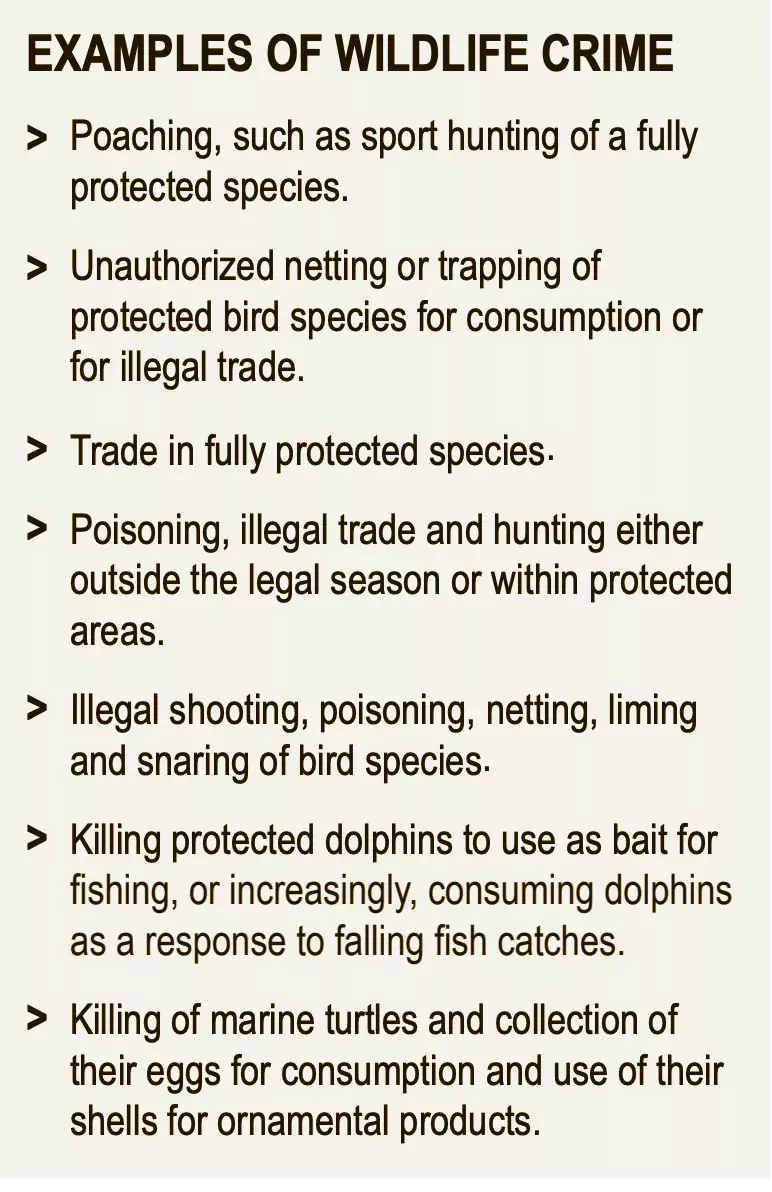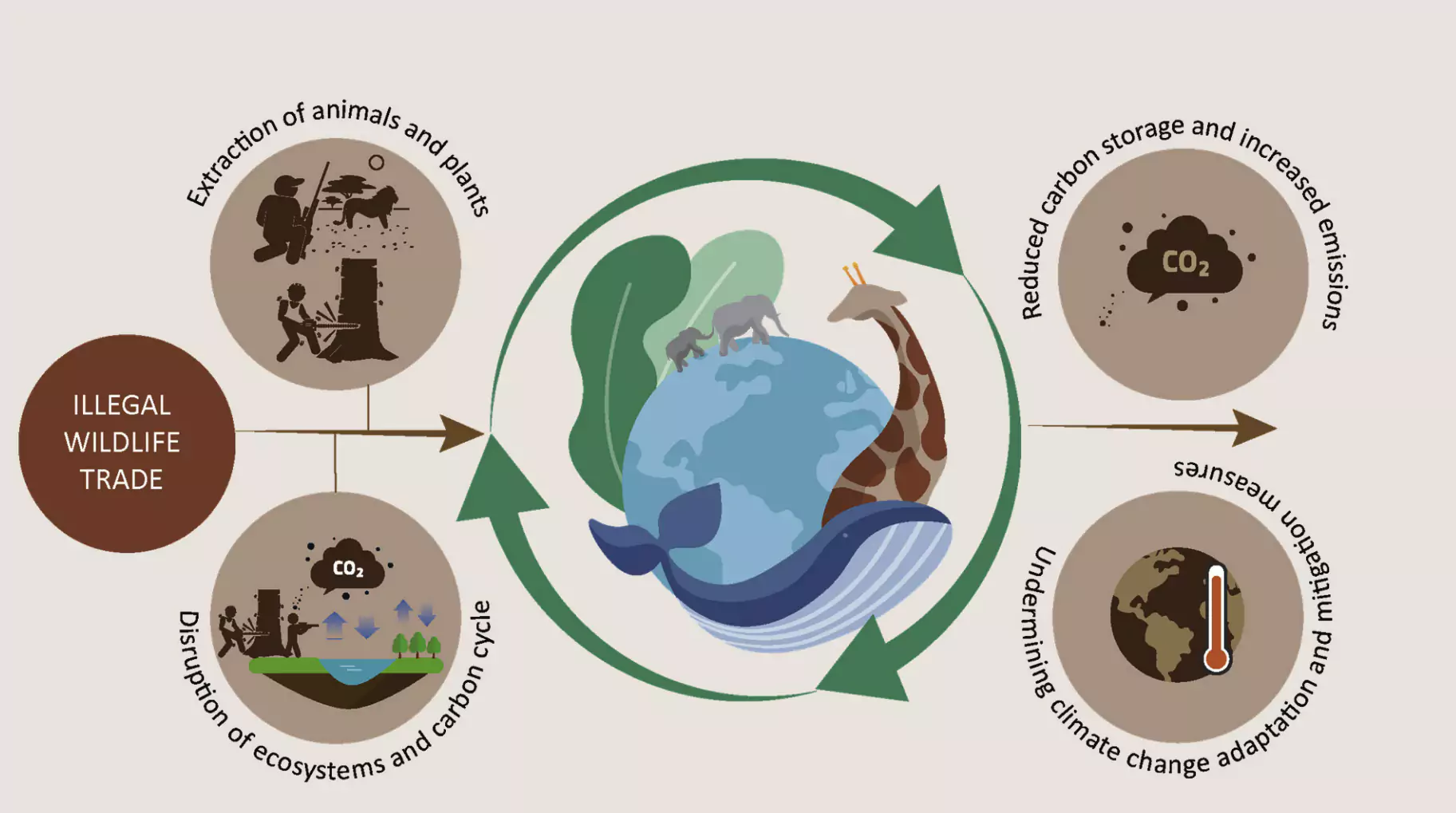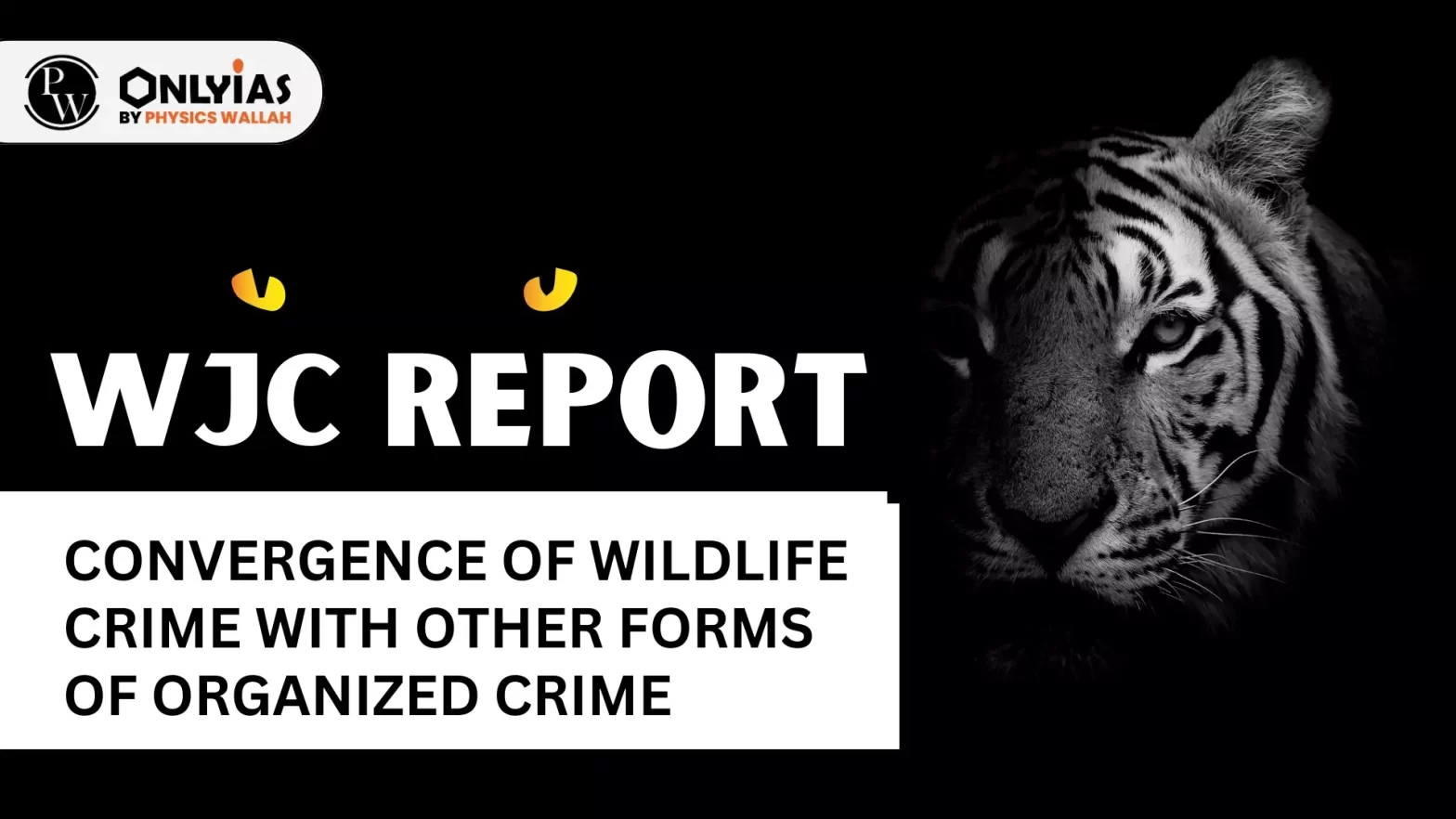Context:
- The report reveals close connections between wildlife trade and various criminal activities, including protection rackets, extortion, murder, money laundering, illicit drugs, tax evasion, and corruption.
- This report, titled “Convergence of wildlife crime with other forms of organized crime: A 2023 Review,” is a follow-up to the 2021 report, which highlighted 12 case studies demonstrating links between wildlife trafficking and human trafficking, fraud, migrant smuggling, illicit drugs, corruption, and money laundering.
- However, it is the first time that it noted sand-mining as a form of environmental crime.
Wildlife Trade and Wildlife Crime
- Wildlife Trade:
- It Involves the sale and exchange of wild animals and plants, including live specimens, parts, derivatives, or transformed products.
- Occurs at various levels, from local to global.
- Regulated internationally by CITES (Convention on International Trade in Endangered Species of Wild Fauna and Flora).
- Wildlife Trade in India: International wildlife trafficking into and out of India mainly occurs through either the Northeast or through airports. Chennai and Mumbai airports are major hubs for this illegal activity.
- Major Trafficking Routes (The 2018 TRAFFIC report In Plane Sight):
- Northeastern Borders: Rhino horns, tiger parts, and pangolin scales are trafficked extensively across the borders with Nepal, Myanmar, and China, with transit sites in cities like Dimapur, Guwahati, and Imphal.
- India-Bangladesh Border: The trafficking of birds and reptiles is prevalent along the India-Bangladesh border.
- Wildlife Crime:
- A significant environmental crime encompassing violations of national, regional, or international laws protecting wildlife species (Refer Image).

Status of Wildlife
- According to WWF’s “Living Planet Report, 2020,” monitored population sizes of various species have declined by an average of 68% between 1970 and 2016.
- A United Nations-backed panel, Intergovernmental Science-Policy Platform on Biodiversity and Ecosystem Services (IPBES), reported in 2019 that up to one million plant and animal species face extinction, with many at risk within decades.
- IUCN’s Red List of Threatened Species indicates that over 41,000 species, or 28% of all assessed species, are threatened with extinction.
- Convergence of Wildlife Crime with Other CrimesReports and analyses highlight the convergence of wildlife crime with various serious crimes:
- A 2018 U.S. Intelligence Community analysis found substantial overlap between wildlife crime and drug trafficking, terrorism, and nuclear-related materials proliferation.
- INTERPOL’s 2015 report identifies links to crimes such as terrorist activities, human trafficking, firearms trafficking, and more.
- The “Shared Skies” report identifies levels of convergence in which trafficking activities occur, from shipment to jurisdiction-level convergence.
- The Wildlife Justice Commission’s 2021 report discusses 12 case studies showing the convergence of wildlife crime with corruption, money laundering, drug trafficking, and more.
The research paper namely “Connections between trades and trafficking in wildlife and drugs” discusses six methods of convergence between wildlife and drugs:
- Combined contraband: Illegal wildlife and illegal drugs in shared shipments
- Camouflage: Legal wildlife used to hide illegal drugs
- Multiple trade lines: Illegal wildlife and illegal drug lines and routes controlled by the same network/group
- Shared smuggling routes and transport methods: Illegal wildlife and illegal drugs being smuggled along the same route, but at different times
- Barter trade: Illegal wildlife in exchange for illegal drugs (and vice-versa)
- Laundering drug money: Legal wildlife industry used to launder the proceeds from illegal drugs
|
Provision to Check Wildlife Crime:
- Global Cooperation in Combating Wildlife Crime
- International Consortium on Combating Wildlife Crime (ICCWC)
- Collaborative effort of five inter-governmental organizations: CITES Secretariat, INTERPOL, the United Nations Office on Drugs and Crime (UNODC), World Bank, and World Customs Organization (WCO).
- Provides coordinated support to national wildlife law enforcement agencies and regional networks.
- ASEAN Wildlife Enforcement Network (ASEAN-WEN):
- A regional inter-agency and inter-governmental organization.
- Combats transnational wildlife trafficking.
- Supports member countries in real-time information sharing and addressing cross-border wildlife crimes.
- Member countries: Brunei, Cambodia, Indonesia, Laos, Malaysia, Myanmar, Philippines, Singapore, Vietnam, Thailand.
- South Asia Wildlife Enforcement Network (SAWEN):
- A regional intergovernmental organization.
- Fosters cooperation among member countries in South Asia to combat wildlife crimes.
- Focuses on policy harmonization, institutional capacity strengthening, knowledge sharing, and collaboration with national, regional, and international partners.
- Member countries: India, Pakistan, Afghanistan, Bangladesh, Nepal, Bhutan, Sri Lanka, Maldives.
- UN Convention Against Transnational Organized Crime (UNTOC), 2000
- The main international instrument to combat transnational organized crime.
- Ratifying states commit to taking various measures against transnational organized crime, including creating domestic criminal offenses (e.g., participation in an organized criminal group, money laundering, corruption, obstruction of justice).
- Establishes frameworks for extradition, mutual legal assistance, and law enforcement cooperation.
- TRAFFIC (Trade Records Analysis of Flora and Fauna in Commerce):
- TRAFFIC, a wildlife trade monitoring network and a joint program of WWF and IUCN, established in 1976, collaborates with national and state governments and various agencies.Mission: To study, monitor, and influence actions that curb illegal wildlife trade and bring legal wildlife trade within sustainable levels.
- Legal Framework in India:
- Wildlife (Protection) Act, 1972: India has a robust legal and policy framework to regulate and restrict wildlife trade.
- The Wildlife (Protection) Act, 1972, prohibits trade in over 1800 species of wild animals, plants, and their derivatives.
- CITES Membership: India has been a member of CITES (Convention on International Trade in Endangered Species of Fauna and Flora) since 1976.
- CITES is an international agreement that ensures international trade in specific species listed on Appendices does not threaten their survival.
- The Wildlife Crime Control Bureau (WCCB): It is a statutory multi-disciplinary body under the Ministry of Environment and Forests, to combat organized wildlife crime in the country.
Constitutional Provisions for Wildlife in India:
- Transfer of Authority: The 42nd Amendment Act of 1976 transferred the subject of “Forests and Protection of Wild Animals and Birds” from the State List to the Concurrent List.
- Fundamental Duty: Article 51 A (g) of the Constitution makes it a fundamental duty of every citizen to protect and enhance the natural environment, including forests and wildlife.
- Directive Principles: Article 48 -A of the constitution says that “the state shall endeavor to protect and improve the environment and to safeguard the forests and wildlife of the country.
|
Also Read: Approach to Wildlife Conservation
Common Facilitating Factors for Wildlife Crime:
- Bribery and Corruption: Corruption is a major driver in terrestrial wildlife crimes, fisheries, and timber. It facilitates illegal activities at every step of the supply chain, including poaching, transportation, processing, and product sales.
- Examples: In the 12 case studies, bribery, and corruption were overtly present, particularly in timber and fisheries crimes, where corruption can extend to high levels of government, such as providing fishing licenses and logging concessions.
- Money Laundering:
- Attractiveness to Organized Crime: Wildlife crime is lucrative, attracting organized crime groups due to the potential for large profits with relatively low risk.
- Laundering of Illicit Financial Flows: High prices for wildlife products like rhino horn and ivory suggest substantial illicit financial flows that may be laundered to conceal their illegal origins.
- Limited Financial Investigations: Many countries do not conduct financial investigations to identify the proceeds of crime or potential money laundering offenses linked to wildlife crime.
- Examples: The United States is one of the few countries that conducts financial investigations.
- Difference in Legislative Framework: One of the main problems that investigators face worldwide is the difference in the legal status of wild animals in various countries.
- For instance, a star tortoise is protected under the Wildlife (Protection) Act, 1972 (WPA, 1972), in India, it is not considered a protected animal in many countries where it is sold freely and legally.
- When the trade of an animal, protected in one country, is not restricted under CITES, then it can be sold as a ‘captive-breed’ to avoid any legal wrangles that could arise.
- For Example: Every year thousands of star tortoises are smuggled from India to other countries to be sold as pets.
- Factors Driving Wildlife Trafficking in India:
- Demand for Raw Materials and Animal Parts:
- High demand for raw materials like red sandalwood and ivory, used in luxury product manufacturing.
- Demand for animal parts, including rhinoceros horn and tiger parts, for traditional medicine.
- Demand for Meat: Wildlife trafficking is driven by the demand for meat from animals such as Bengal slow loris, softshell turtles, deer, antelope, wild cattle, and sea cucumbers.
- Exotic Pets:
- Growing demand for exotic pets, especially birds like cockatoos, macaws, and gray parrots.
- Indian birds, fish, and reptiles are also in demand in global pet markets.
Impact of Wildlife Trade on the Environment
- Depletion of Natural Inhabitants: Wildlife trade leads to the depletion of natural habitats and populations of native species, including tigers, elephants, rhinos, pangolins, and star tortoises.
- Example: In April 2010, the last known Vietnamese Javan rhinoceros. The animal—the final member of the subspecies Rhinoceros sondaicus annamiticus—was killed by poachers.
- Spread of Invasive Species: Introduction of invasive species into ecosystems, such as red-eared slider turtles and suckermouth sailfin catfish, due to the pet trade.
- Example: Burmese Python Species
- Native to Africa, Asia, and Australia become problematic in US due to their popularity as pets.
- However, by way of an accidental release, one such popular pet snake species, the Burmese python, was introduced in South Florida.
- They have since established a breeding population and are now considered to be one of the most concerning invasive species in the Everglades National Park.

- Emergence of Zoonotic Diseases: Close human-wildlife contact in wet markets and wildlife trade can lead to the emergence of zoonotic diseases.
- Virulent diseases like Ebola, Marburg virus disease, SARS, and COVID-19 have been linked to such interactions, posing threats to human health and ecosystems.
Species-Specific Operations in India:
- Operation Save Kurma: Targets the poaching, transportation, and illegal trade of live turtles and tortoises.
- Operation Lesknow: Aims to address the illegal wildlife trade involving lesser-known species.
- Operation Clean Art: Focuses on the illegal wildlife trade in mongoose hair brushes.
- Operation Birbil: Aims to curb the illegal trade in wild cat and wild bird species.
- Operation Wildnet: Targets the growing illegal wildlife trade on the internet, particularly through social media platforms.
|
Way Forward for Combating Wildlife Crime:
- Marine Smuggling in Coastal Regions: India’s coastal regions are vulnerable to the smuggling of marine species like sea cucumber, sea horse, shark fins etc. Synergy among the Indian Coast Guard and Forest/Police/Customs is crucial to counter marine wildlife smuggling.
- Cross-Border Wildlife Trafficking: India’s land borders with Nepal, Bhutan, Bangladesh, Myanmar, and China are also exploited by wildlife traffickers.
- Enhanced coordination and cooperation are needed among security forces like Assam Rifles, Border Security Force, Indo-Tibetan Border Police, and Sashastra Seema Bal to counter cross-border wildlife trafficking effectively.
- For Example: In 2018, Chinese Customs (Xiamen) detected endangered species smuggling involving suspects A and B. They bought pangolin
- scales from Nigeria to Vietnam and smuggled
- them into China.
- Xiamen Customs informed the Vietnamese Customs authority and started a joint operation
- Addressing Wildlife Crime as Financial Crime:
- Establish coordination and cooperation between FIU-India, and Forest/Police/Customs/ for sharing financial intelligence related to wildlife trafficking.
- Use provisions of the Prevention of Money Laundering Act (PMLA) to investigate and curb wildlife crime as a financial crime.
- Recommendation by the WJC Commission:
- Intelligence Collection and Comprehensive Wildlife Datasets:
- Emphasize the need for governments to establish comprehensive wildlife datasets.
- Advocate for better intelligence collection methods.
- Stress the importance of developing frameworks and protocols for secure and timely intelligence sharing.
- Organized Crime Group Mapping:
- Promote the use of organized crime group mapping as an essential tool.
- Identify points of convergence and focus on tackling wildlife crime from an organized crime perspective.
- Prioritize law enforcement efforts based on the threat posed by specific organized crime groups and their motivations to commit crimes.
- Multi-Agency Cooperation and Joint Investigations:
- Encourage multi-agency cooperation and joint investigations.
- Alternative Legislation for Convergent Offenses:
- Suggest considering the use of alternative legislation when relevant.
- Enable strategic decision-making regarding law enforcement powers and penalties, enhancing the response to convergence.
- Financial and Corruption Investigations:
- Advocate for conducting financial and corruption investigations alongside wildlife crime cases.
- Identify money laundering, corruption offenses, and payment methods.
- Facilitate asset recovery by tracing the proceeds of crime.
- Specialized Investigative Techniques:
- Promote the greater utilization of specialized investigative techniques, including
- Communications interception
- Undercover operations
- Use of listening and tracking devices
- Controlled deliveries
- Enhance understanding of potential convergence between wildlife crime and other serious crime types.
- Develop coordinated law enforcement responses when such convergence is identified.
Also Read: 2023 UN Climate Change Conference (UNFCCC COP 28)
Conclusion:
The report by the Wildlife Justice Commission highlights the urgent need for comprehensive international collaboration, enhanced intelligence sharing, and specialized investigative techniques to address the alarming convergence of wildlife crime with various forms of organized crime, posing a critical threat to both biodiversity and global security.
| Prelims Question (2017)
Consider the following statements in respect of Trade Related Analysis of Fauna and Flora in Commerce (TRAFFIC):
1. TRAFFIC is a bureau under United Nations Environment Programme (UNEP).
2. The mission of TRAFFIC is to ensure that trade in wild plants and animals is not a threat to the conservation of nature.
Which of the above statements is/are correct?
(a) 1 only
(b) 2 only
(c) Both 1 and 2
(d) Neither 1 nor 2
Ans: (b) |



